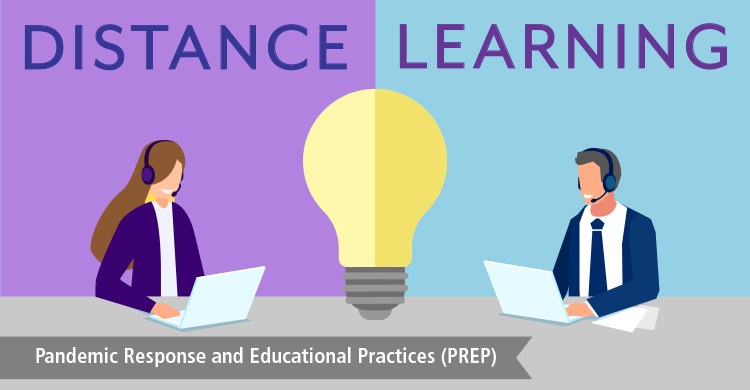This entry is the seventh in a blog series called Pandemic Response and Educational Practices (PREP), which aims to highlight and further the important work educators are doing amid the worldwide COVID-19 crisis.
Based on How to Coach Leadership in a PLC.
These are times unlike any we have faced in our careers, but they also are quite possibly the most profound opportunity for leadership growth that we have ever been provided as well.
It is important, however, that we embrace the concept of distributed leadership as well. Teacher leadership within grade-level and subject-matter teams during this time is essential. Effective and focused team collaboration is needed to generate the learning opportunities for our students and support them through difficult changes. Now is the time to deepen our collaborative culture, not to abandon it!
Here are some thoughts and reminders I have been pondering as I have connected with superintendents and principals during this time.
Have we reminded ourselves what real collaboration is, and do we see this as an opportunity to grow?
Collaboration is a systematic process, in which we work together, interdependently, to analyze and impact professional practices (DuFour, DuFour, Eaker, 2002).
Collaboration is not a meeting; it is a process, and if we embrace that concept, we then understand that powerful collaboration can occur even in a time of shelter in place and social distancing.
Teachers are having Zoom meetings with their students, and districts are staying connected with site leaders in the same way, but have we set the same expectations that our teams will stay connected?
- How often are our teams actually connecting to develop a collective commitment to the learning our students must be engaged in each week?
- How often are principals engaging in conversations with their teacher team leaders to assure they are still a team, ensure that they have a learning-centered focus, and determine where teams may need extra support?
- How often are principals connecting to share their learning and their struggles and support one another as a team during this time?
A lot of our teams have members who struggle with technology, and we are behind the curve in our professional development here; how do we overcome that deficit quickly?
I have heard this comment a lot recently, and it is true; we have not built the capacity in all our staff to navigate systems or even utilize navigation tools effectively, but here, again, we can use the team to build the team.
Of course, that assumes we embrace the right concept of team and then build on that. Rick DuFour would constantly remind us that in the world of a professional learning community, (exactly what we must be in this time) a team is a group of people working together interdependently to achieve a common goal for which they are mutually accountable.
Building on that concept of team to address the gaps that some staff have in utilizing technology effectively, Michael Fullan reminds us “capacity building is not just workshops and professional development; it is the daily habit of working together!”
So again, the need is for effective collaboration so that we can use the team to build the team.
- Many of our teams have members who have incredible knowledge and skills related to using technology, supporting distance learning, accessing or creating valuable learning opportunities for kids. How are we supporting our teams to draw on those “tech-sperts” to support and build the capacity of their team members?]
- How are we identifying those technology leaders and connecting them in a learning network and helping to create team, site, and district resources?
- How are we reminding our teams that these students are not your kids and my kids, they are our kids? At the same time recognizing that some members of the team may be facing real challenges at home (the teacher whose wife is a nurse, and he is home caring for their five children while she works), how do we develop a division of labor as a team to effectively push out the learning to our kids and support team members in their unique situations as well?
How do we assure that we are focused on LEARNING in the time we have left this year, and not just keeping kids busy at home?
The first big idea of a professional learning community is an absolute, relentless commitment to learning. It is essential that we make sure our teams are developing a collective commitment to supporting the learning of their students and keeping their collaboration anchored in and driven by that commitment.
With distance learning being a relatively new concept to most of us, it is very easy to lose focus and digress to asking, “What are we going to have our kids do this week?”
Instead, the conversation must be centered first on “What is it our kids need to learn this week?” and then “How shall we have them access that learning?”
We also need to be careful that we are not overloading our kids and overwhelming our parents during this time as well. Finally, we have to define the learning that must happen between now and the end of the year, to lay the foundation for next year.
- How are we connecting with teams to determine they have identified the essential learning that must occur in the time we have left and that all students that each team serves are connected to that essential learning?
- Have our teams had a vertical articulation conversation with the teams that will be receiving their kids next year, to make sure that what they see as essential includes the foundational knowledge and skills needed as foundations to build on next year?
- Are we documenting and archiving our learning focus in this time so that we know how to measure learning and close any learning gaps as we open next year?
- How are we preparing now the steps we will take when we open next year to know our kids “by name and by need” and move quickly to meet their needs?
- How are we monitoring learning?
- How are we supporting families and connecting them with resources and with the workload have we defined as the “must do” (work and activities tied to essential learning, the “must knows”) and the “can do” (work and activities that are aligned with “nice to know” learning) so that they don’t feel overwhelmed with the workload?
- How are we sharing our team learning to strengthen our system learning?
Are we taking advantage of the opportunity to actually develop a stronger culture of collaboration and a commitment to learning?
Culture is something that is constantly developing, and is simply defined as “how we do things around here.”
Influencing culture requires that we “alter long-held assumptions, beliefs, expectations, and habits that represent the norm for people in the organization” (DuFour, Fullan, 2013).
This time will impact our culture, either with us or without us. We can cultivate a stronger collaborative culture, or we can simply let things evolve and hope we can pick up the pieces when things get back to normal. Rick DuFour used the term cultivation to describe the need to influence culture, and cultivate is the right verb.
Living in an agricultural region, we understand cultivation is an ongoing process, not a one-and-done event. If you have ever grown a garden, you know that if you go on vacation for two weeks, there will be weeds when you return.
The same is true with our organizational culture at all levels—team, site, and district—during this time. If we don’t cultivate a stronger collaborative culture during this time, we will have weeds in our garden, so how are we tending our garden?
- How are we communicating a sense of team? (“We are in this together, and we must work together to get through it.”)
- How are you communicating the need for team collaboration, the benefits of team collaboration, and expectations that we will collaborate, because it is what our kids need us to be doing?
- Have we clearly defined the outcomes that we are seeking in this time, and how are we messaging to develop clarity regarding and commitment to those outcomes?
- How are you celebrating wins as evidence of progress toward our outcomes?
- How are we communicating today’s learning through the organization to support tomorrow’s improvement?
- How will we document our system learning as a way to be better prepared for the next time we face a “new normal”?
- How are we reminding our organizations that if “all really means all,” we need to continuously be seeking to identify, connect, and support all learners (both young and adult), including the struggling, the reluctant, the resistant, and the disconnected, and sharing structures and strategies that are supporting success?
- How are we helping all to see that this is a time of opportunity to improve, not a challenge to be endured?
As we continue to connect and share our learning on this journey, I will continue to seek ways to connect and support you and share your learning. One last point to ponder: I have heard of some systems where there has been pushback and resistance to action because not all kids had access to the learning. The argument seemed to be couched as an equity issue.
Remember, equity is not something that is achieved by waiting for it; equity is achieved and becomes our reality through action. We have to see this as a journey of improvement and realize that on a journey of improvement, there is no place on the pathway called “good enough.” Use each day as a building block for a better tomorrow.
Every child, every day, whatever it takes!
On behalf of the kids you serve, thank you for your passion and persistence. Lead with courage and with heart. Tend the garden.
How to Coach Leadership in a PLC is available for purchase on Amazon or SolutionTree.com.
[author_bio id=”251″]






